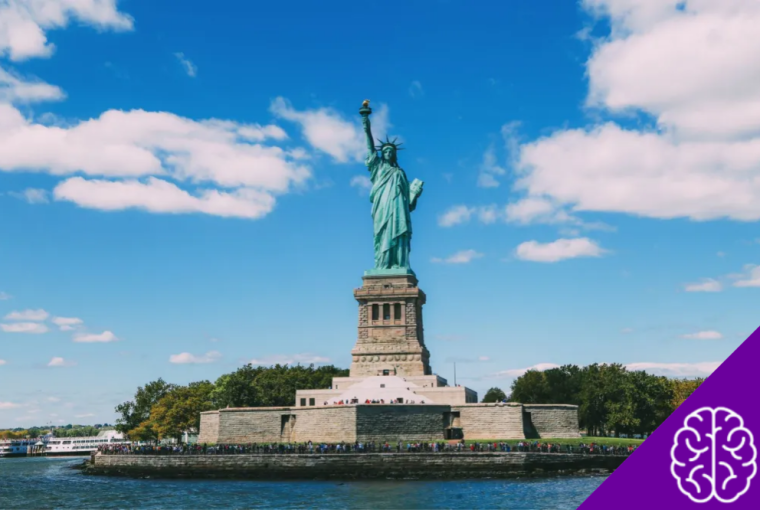Facts About the USA: The United States remains one of the world’s most fascinating destinations, attracting millions of visitors annually with its diverse culture, impressive landscapes, and unique way of life.
While most people know about American staples like hamburgers, Hollywood, and the Statue of Liberty, there’s a treasure trove of lesser-known facts that reveal just how different life can be across the pond.
Whether you’re planning your first trip to America, considering a move, or simply curious about American culture, these surprising insights will help you understand what makes the USA truly unique. From unusual laws that vary by state to everyday customs that might catch you off guard, these facts paint a fuller picture of American life beyond the movies and media portrayals.
Get ready to discover some genuinely eye-opening details about the land of the free and home of the brave—many of these might completely change your perspective on American culture.
Unique American Customs and Daily Life
Extended Weekend Holidays Are Built Into the System
Americans have mastered the art of the long weekend through strategic holiday scheduling. When a federal holiday falls on a Saturday, the preceding Friday becomes a day off for most federal employees. Similarly, if a holiday lands on Sunday, the following Monday is observed as the holiday instead.
This practice extends beyond just federal workers, as many private companies follow the same system. Take Thanksgiving, for example—it always falls on the fourth Thursday of November, automatically creating a four-day weekend when combined with the following Friday (known as “Black Friday”).
This systematic approach to maximizing time off reflects Americans’ value of work-life balance, even within their notoriously busy culture.
Installment Payments Aren’t Standard Practice
While many countries embrace payment plans and installments as standard retail practice, the United States takes a different approach.
Unlike Brazil, where splitting purchases into multiple payments is common, American stores typically don’t offer direct installment options.
Instead, consumers rely on third-party financing companies or credit cards to spread out large purchases.
This system has evolved significantly in recent years with the rise of “buy now, pay later” services like Afterpay and Klarna, but traditional installment plans remain far less common than in many other countries.
Breakfast Is a Serious, Calorie-Dense Affair
The American breakfast deserves its reputation as a substantial meal. While many cultures prefer lighter morning fare, Americans embrace hearty combinations that can easily exceed 800 calories per serving.
Classic breakfast plates feature eggs, bacon, sausage, hash browns, and pancakes or waffles, often accompanied by syrup, butter, and orange juice.
This tradition stems from agricultural roots when manual laborers needed substantial fuel for physically demanding workdays. Modern American breakfasts maintain this generous approach, though health-conscious alternatives have gained popularity in urban areas.
The contrast with lighter international breakfast styles—like European pastries or Asian rice dishes—is striking and reflects broader cultural attitudes toward food and energy.
Geographic and Legal Surprises
State Laws Create a Patchwork of Regulations
One of the most surprising aspects of American life is how dramatically laws can change from state to state.
This federalist system creates a complex legal landscape where something perfectly legal in one state might be prohibited just miles away across a state border.
Marijuana legalization provides a perfect example—it’s fully legal for recreational use in states like California and Colorado, while possession remains a criminal offense in states like Texas and Georgia. Similarly, abortion access, gun regulations, and even speed limits can vary significantly between neighboring states.
This system requires Americans to stay informed about local laws when traveling, and it creates unique situations where identical actions can have vastly different legal consequences depending on location.
The USA Ranks Among the World’s Largest Countries
With approximately 3.8 million square miles of territory, the United States claims the fourth position among the world’s largest countries by land area. Only Russia, Canada, and China exceed its geographic footprint.
This massive territory encompasses everything from Arctic conditions in Alaska to tropical climates in Hawaii and Florida.
The country’s size becomes even more impressive when considering population density. With roughly 333 million residents, America ranks third globally in population after China and India, yet maintains vast open spaces and relatively low population density compared to other major nations.
Driving Starts Young, but Drinking Starts Late
American age restrictions present an interesting paradox that often confuses international visitors.
Teenagers can begin learning to drive at 14 in some states like Arkansas, with most states allowing full licenses between 16 and 18 years old. This early driving age reflects the car-centric nature of American society and the vast distances between many communities.
However, the legal drinking age remains firmly set at 21 across all states—significantly higher than most developed nations.
This three- to seven-year gap between driving and drinking privileges creates a unique cultural dynamic where young adults can operate vehicles, vote, serve in the military, and get married years before they can legally purchase alcohol.
Surprising Social Norms and Etiquette
Tipping Culture Is Mandatory, Not Optional
American tipping culture operates as an essential part of the service economy rather than a simple gesture of appreciation.
Standard tipping ranges from 18-22% at restaurants, with many establishments now suggesting even higher percentages through digital payment systems.
This system extends beyond restaurants to include bartenders, taxi drivers, hotel housekeeping, hair stylists, and delivery personnel.
Failing to tip appropriately isn’t just considered rude—it can significantly impact service workers’ income since many earn below minimum wage with the expectation that tips will make up the difference.
International visitors often struggle with this system, as tipping customs vary dramatically worldwide. Understanding when, where, and how much to tip becomes essential for navigating American service interactions successfully.
Punctuality Is Taken Seriously
American business culture places enormous emphasis on punctuality, often more so than many international counterparts expect. Arriving even five minutes late to a business meeting can be perceived as disrespectful and unprofessional.
This time-consciousness extends beyond formal business settings into social situations, medical appointments, and service interactions. Americans frequently arrive early to important appointments and may become noticeably uncomfortable when others run behind schedule.
This cultural trait reflects broader American values around efficiency, respect, and personal responsibility.
Public Alcohol Consumption Is Widely Prohibited
Unlike many European and South American countries where enjoying a beer on the street is perfectly acceptable, most American states strictly prohibit public alcohol consumption. This restriction applies to parks, beaches, sidewalks, and most outdoor spaces.
When purchasing alcohol, stores package it in paper bags—a practice designed to maintain discretion and comply with public consumption laws.
Violating these regulations can result in fines, citations, or even arrest, making this one of the most important cultural differences for international visitors to understand.
Unique American Household Features
Garbage Disposals Are Standard Kitchen Equipment
American kitchens commonly feature garbage disposals built into sink drains—a convenience that surprises many international visitors.
These electric units grind food waste into small particles that flush away through the plumbing system, reducing food waste in trash bins and preventing drain clogs.
This technology reflects American preferences for convenience and efficiency in household management.
While environmental concerns about water treatment have led some communities to discourage disposal use, they remain standard features in most American homes and apartments.
The Number 13 Simply Doesn’t Exist
American superstition around the number 13 runs so deep that many buildings skip it entirely. Elevators frequently jump from the 12th floor directly to the 14th, while hotels and office buildings avoid room numbers, floor numbers, and even street addresses containing 13.
In New York City, an estimated 80% of buildings omit the 13th floor designation. This practice, known as triskaidekaphobia, demonstrates how deeply cultural superstitions can influence practical architecture and urban planning decisions.
Educational and Professional Differences
The School Year Follows a Different Calendar
American schools typically begin their academic year in late August, designed to align with seasonal patterns and agricultural traditions.
This schedule differs significantly from countries like Brazil, where the school year begins in February during summer months.
The August start allows American schools to conclude before summer’s peak heat in June, providing a long summer break that historically accommodated agricultural work schedules. This timing also aligns winter break with the holiday season, creating natural family gathering opportunities.
Lunch Breaks Are Minimal or Nonexistent
American workplace culture treats lunch very differently than many international counterparts. Instead of extended lunch periods common in European or Latin American cultures, American workers typically receive 15-30 minute breaks for quick meals.
Many professionals eat at their desks while working, grabbing fast food or pre-prepared meals that can be consumed quickly.
This efficiency-focused approach reflects broader American attitudes about productivity and time management, though it also contributes to higher stress levels and less social interaction during workdays.
Religious and Cultural Diversity
Protestantism Dominates Religious Practice
Approximately 75% of Americans identify as Protestant Christians, encompassing denominations like Methodist, Lutheran, and Baptist traditions. This Protestant majority shapes many cultural norms, holiday celebrations, and community organizations throughout the country.
Despite this religious dominance, America maintains remarkable religious diversity. The country hosts significant Catholic, Jewish, Muslim, Hindu, and Buddhist communities, along with growing numbers of non-religious Americans.
This diversity creates a complex religious landscape where local customs can vary dramatically based on regional demographic patterns.
Economic and Consumer Culture
America Leads Global Consumption
The United States consistently ranks as the world’s most consumer-oriented society, with Americans purchasing and discarding goods at rates that exceed most other developed nations. This consumption pattern drives significant economic activity but also generates substantial waste streams.
American retail culture emphasizes constant product updates, seasonal shopping events, and promotional pricing designed to encourage frequent purchases.
This economic model supports high employment in retail and manufacturing sectors while creating environmental challenges around waste management and resource consumption.
Self-Service Is the Standard Expectation
American consumer culture heavily emphasizes self-service across multiple industries. Gas stations require customers to pump their own fuel (except in Oregon and New Jersey), grocery stores feature extensive self-checkout options, and many restaurants operate on self-seating principles.
This self-service approach reflects American values around independence, efficiency, and cost reduction.
While some find this system impersonal, it allows businesses to maintain lower prices while giving consumers more control over their shopping experience.
Healthcare and Social Services
Healthcare Operates as a Private Market
Unlike countries with universal healthcare systems, the United States treats medical care primarily as a market commodity.
Hospital visits, doctor consultations, prescription medications, and emergency services all carry significant costs that patients must pay through insurance or personal funds.
This system creates substantial financial barriers to healthcare access, with medical bankruptcy remaining a leading cause of personal financial crisis.
The absence of universal healthcare coverage represents one of the most significant differences between American and international social support systems.
Unique American Barbecue Culture
Grilling Means Something Different
American barbecue culture centers around hamburgers, grilled chicken, hot dogs, and sausages rather than the large cuts of beef common in South American traditions.
Typical American barbecues feature side dishes like baked beans, coleslaw, potato salad, and corn on the cob.
Regional barbecue styles vary dramatically across the country, from Kansas City’s molasses-based sauces to Carolina’s vinegar-based preparations.
This diversity reflects broader patterns of regional American cuisine influenced by immigration, agricultural products, and historical settlement patterns.
Surprising Home Design Elements
Bathrooms Rarely Include Floor Drains
American bathroom design typically excludes floor drains outside of shower enclosures, contrasting with many international approaches that include drainage throughout bathroom floors.
This design choice reflects different cleaning practices—Americans typically use damp cloths for floor cleaning rather than hosing down bathroom areas.
This architectural difference can surprise international residents who expect more comprehensive water management in bathroom spaces, highlighting how cultural cleaning practices influence basic home construction standards.
What These Facts Reveal About American Culture!
These surprising facts illuminate the complexity and diversity of American culture beyond popular stereotypes.
From legal variations between states to unique social customs around tipping and punctuality, the United States presents a fascinating study in regional differences within a unified national identity.
Understanding these cultural nuances becomes essential for anyone planning to visit, study, work, or live in America.
While movies and media provide some cultural context, these real-world insights offer more practical preparation for navigating American society successfully.
The next time you encounter American culture—whether through travel, business, or entertainment—remember that surface-level observations often mask deeper cultural complexities that make the United States one of the world’s most intriguing countries to explore!


